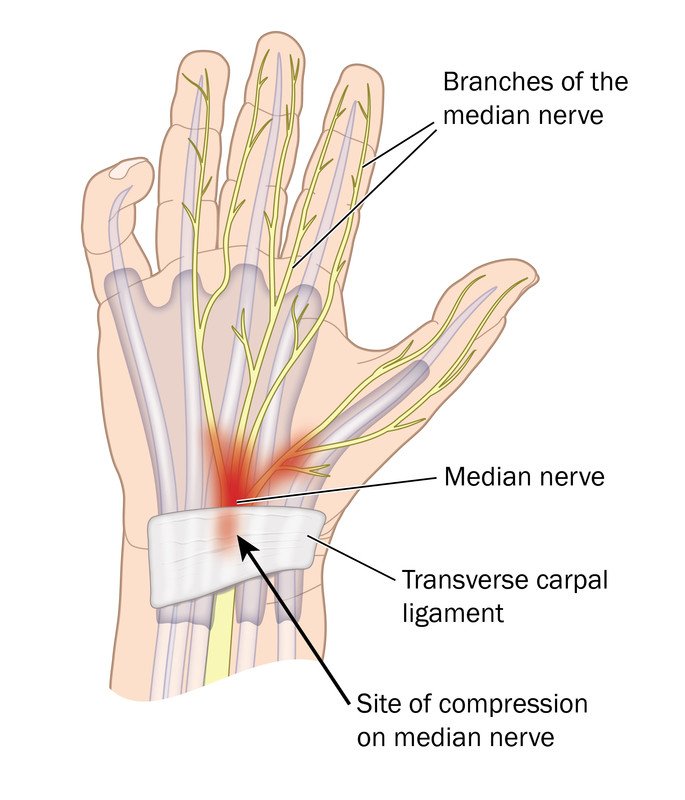Carpal tunnel syndrome
Medically reviewed by Drugs.com. Last updated on Oct 25, 2023.
What is carpal tunnel syndrome?

In the wrist, nerves and tendons pass through a narrow space called the carpal tunnel.
A major nerve (the median nerve) that passes through this tight space, can become irritated or compressed. Carpal tunnel syndrome is a combination of numbness, tingling, pain and weakness in the hand caused by compression of the median nerve in the carpal tunnel.

Symptoms tend to show up most in the thumb, index finger, middle finger and half of the ring finger because the median nerve provides sensation to those areas.
Because the carpal tunnel already is narrow, the nerve can become irritated if it narrows even a little more. Injury to the nerve also can cause carpal tunnel syndrome. There are several common causes, including:
- arthritis or fracture near the wrist
- pregnancy
- diabetes
- overuse (as in typists, cashiers or certain athletes)
- thyroid disease, particularly an underactive thyroid.
Often, carpal tunnel syndrome occurs without a clear reason. The condition affects women more often than men, perhaps because women normally have smaller carpal tunnels. It can occur in one or both hands.
Symptoms of carpal tunnel syndrome
Symptoms of carpal tunnel syndrome can include:
- burning, tingling or numbness of the fingers
- difficulty gripping and hold tools, pens, eating utensils and other objects
- problems making a strong fist.
Symptoms may appear first at night and are most noticeable in the thumb and the index and middle fingers. People with carpal tunnel syndrome often describe awakening with a tingling sensation and the need to shake out the hands to recover normal feeling. There can be pain in the wrist that radiates into the hand or into the forearm. If the condition is not treated, the muscles of the thumb can waste away so that the normal mound of muscles at the base of the thumb eventually flattens.
Diagnosing carpal tunnel syndrome
The diagnosis of carpal tunnel syndrome can be strongly suspected based on the description of symptoms. Your doctor will look for decreased feeling in your fingers and for muscle weakness in your hand. Your doctor will check your thumb muscles for signs of wasting and your wrists for signs of arthritis. Your doctor may check whether fluid is accumulating in several different parts of your body, including your hands, feet and legs, since extra fluid can add pressure in the carpal tunnel.
The examination will probably include tests to check whether the nerves in your wrist are working well. The Tinel's test is done by tapping over the median nerve at the wrist. In Phalen's maneuver, the wrist is flexed for 30 to 60 seconds. If you develop pain, numbness or tingling during these tests, the median nerve in the carpal tunnel may be compressed.
Doctors usually diagnose carpal tunnel syndrome based on a combination of your history of hand symptoms and the physical examination. X-rays are rarely helpful. Your doctor can confirm the diagnosis of carpal tunnel syndrome by ordering nerve tests (called nerve-conduction studies) of the median nerve in your affected hand. These tests are not perfect, however. In some people, symptoms or an examination suggest carpal tunnel syndrome, but the nerve tests are normal. Your doctor may order blood tests to look for evidence of diabetes or thyroid disease since these are common triggers of carpal tunnel syndrome. Ultrasound or MRI imaging may be helpful when the diagnosis remains uncertain.
Treatment options
The following list of medications are related to or used in the treatment of this condition.
Expected duration of carpal tunnel syndrome
How long carpal tunnel syndrome lasts depends on the cause. Sometimes symptoms come and go and don't require immediate treatment. A person who has carpal tunnel syndrome caused by overuse during sports may recover quickly with treatment, rest and modified activity. In someone whose carpal tunnel syndrome is caused by arthritis, symptoms may be more stubborn and require longer therapy.
Preventing carpal tunnel syndrome
If you type or use a computer keyboard, you can decrease your risk of carpal tunnel syndrome by making sure that you work in a "wrist neutral" position, with the wrist joint straight, not bent up or down. To help you do this, several types of office aids are available, including a cushioned wrist rest and a keyboard tray that adjusts to a position below the work surface. Newer keyboards are being developed, including ones that split the keys into left-hand and right-hand groups, and others that bend the keyboard into a tent shape. You also may need to check the position of your hand when you use a computer mouse or trackball because some experts suspect that people who use these computer accessories consistently are more likely to develop carpal tunnel syndrome. If you continue to have symptoms, you may want to have a professional check your workstation.

Image: Thinkstock/Getty Images
To prevent sports-related carpal tunnel syndrome, ask your trainer or a sports medicine physician about effective ways to support your wrist during high-risk activities.
Treating carpal tunnel syndrome
In most cases of carpal tunnel syndrome, treatment begins with a wrist splint to be worn mainly at night. You may also receive anti-inflammatory medication to decrease pain and numbness. Injections of cortisone may help reduce swelling, but they tend to provide only temporary relief. For people who don't improve with nonsurgical treatments, surgery can relieve pressure on the median nerve by cutting a ligament at the bottom of the wrist, which creates more room for the nerve in the carpal tunnel.

Image: Daisy-Daisy/Getty Images
When to call a professional
Call your doctor if you feel pain, tingling or numbness in your fingers that does not go away. If you have trouble grasping objects, making a fist or have weakness in your hand or arm, you should see your doctor.
Prognosis
The prognosis of carpal tunnel syndrome depends on the cause. For example, when it occurs in the setting of longstanding, poorly controlled diabetes or rheumatoid arthritis, the nerve injury may be permanent. However, most people with carpal tunnel syndrome recover completely with treatment.
Additional info
National Institute of Arthritis and Musculoskeletal and Skin Diseases
https://www.niams.nih.gov/
Learn more about Carpal tunnel syndrome
Treatment options
Care guides
Further information
Always consult your healthcare provider to ensure the information displayed on this page applies to your personal circumstances.
